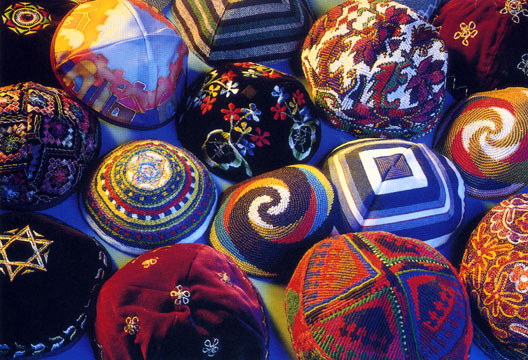
The kippah is a head-covering. It is also called a yarmulke in Yiddish and often rendered "skullcap" in English. The Torah does not mandate a head-covering. Hence it is not a mitzvah (commandment) and there is no berakhah (blessing) recited upon putting it on one's head. It is likely that the custom of covering one's head derives from the attire of the High Priest in the days when the Temple in Jerusalem stood. The High Priest garb included a head-covering. When the Pharisees democratized Judaism and taught that each person is like a priest to God and each table an altar, the custom of wearing a head-covering was transferred to ordinary people as a means of expressing awareness of, and respect for, God throughout one's day. The Talmud tells us that Rav Huna (a Palestinian sage who lived in the 4th century, C.E.) never walked four amot (approximately six feet) with his head uncovered. When asked why, he replied, "Because the shechinah (Divine Presence) rests above my head." From this, we derive the meaning of wearing a kippah: to remind us of God's presence and that there is something higher and greater than we. In a world of self-indulgence and self-worship, that is a valuable message. The Talmud (Shabbat 15b) puts it this way: Cover your head so that awe of heaven will be upon you." The term "yarmulke" has been explained as yireh melekh (fear or awe of the King). The custom of covering one's head. It would seem that the custom of wearing a head-covering grew slowly, over time. Originally, the kippah was worn for prayer, religious study, and while eating. By the 1500's, it was universally accepted among Jews as the proper dress throughout the day. Today, some Jews cover their heads throughout the day (except when bathing and swimming); others while praying, studying sacred texts, and eating; others not at all. In liberal synagogues, both men and women will cover their head or not, as is the custom. In Orthodox synagogues, only men are required to cover their heads.
While wearing a kippah is not a commandment and there is no accompanying blessing, for some, the morning blessing oter Yisrael b'tifarah ("...Who crowns Israel with glory...") serves as a sort of blessing.

A kippah may be made out of fabric or crocheted. It can be decorated any number of ways, with embroidery, needlepoint, fabric paint, applique, or designs knitted into it in the case of a crocheted kippah. The designs may be geometric or might include the wearer's name.